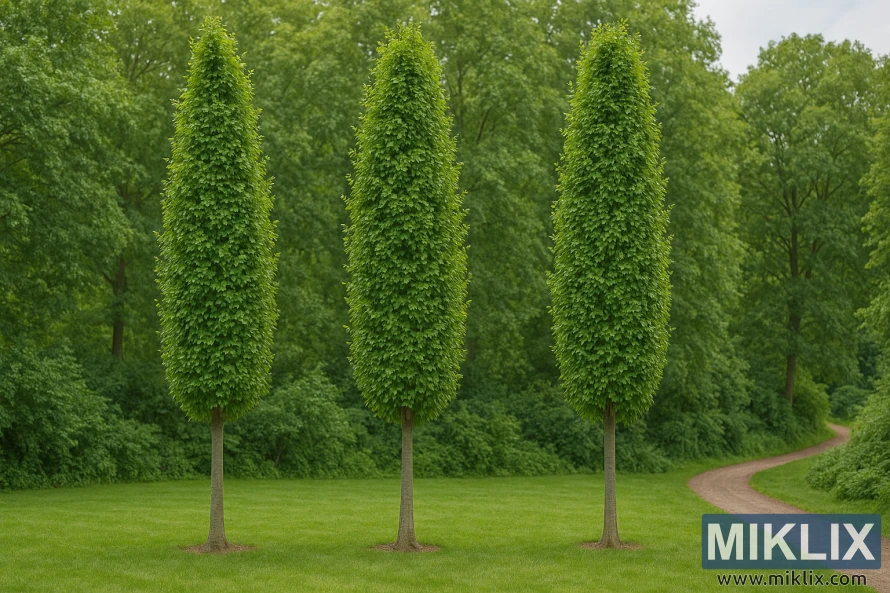Image: Columnar European Beech Trees
Published: August 28, 2025 at 10:13:39 AM UTC
Last updated: September 28, 2025 at 8:34:15 AM UTC
Three Columnar European Beech trees with tall, narrow upright canopies stand on a manicured lawn, adding structure and elegance to the garden.
In this carefully composed landscape, three Columnar European Beech trees (Fagus sylvatica ‘Fastigiata’) rise with striking verticality, their tall, narrow silhouettes lending the scene a sense of order and elegance. Unlike their broad-canopied relatives, these beeches channel their energy upward, forming dense, spire-like columns of glossy green foliage that command attention with their architectural form. Planted equidistantly on a lush, manicured lawn, they appear almost as living sculptures, each trunk standing straight and smooth, clothed in the silvery-gray bark characteristic of the species. Their uniformity and symmetry evoke both natural beauty and deliberate design, transforming this section of garden into a space that feels structured, refined, and enduring.
The dense canopy of each tree is packed with vibrant leaves, their glossy surfaces catching and reflecting light in shifting tones of green. This creates a textured surface that softens the rigid geometry of their shape, ensuring that while the trees remain formal in habit, they also radiate vitality and richness. Seen together, the three columns form a rhythmic sequence, almost like a procession of sentinels standing watch along the edge of the lawn. Their placement suggests both practical and aesthetic considerations, as they frame the view toward the softly curving garden path that meanders into the woodland backdrop. The path’s gentle bend contrasts with the vertical strictness of the trees, balancing the landscape with a sense of flow and movement.
Behind them, the deeper green of the surrounding forest enhances their effect, acting as a backdrop that highlights the columnar beeches’ sharper lines and brighter foliage. This interplay between background and focal trees amplifies their presence, much like a painting’s contrasting tones draw the eye to its subject. The result is a landscape that feels both carefully curated and harmoniously natural, where the ordered presence of cultivated trees meets the wildness of the woodland edge.
These Columnar European Beeches exemplify why the variety ‘Fastigiata’ is so prized by gardeners and landscape architects. Their space-efficient form makes them ideal for gardens where horizontal room is limited but vertical impact is desired. They can be used to line avenues, punctuate borders, or act as focal points in compact lawns, offering an enduring sense of grandeur without overwhelming their surroundings. Even as single specimens, they add drama and elegance, but planted in a grouping—as in this image—they achieve a heightened architectural presence, reminiscent of columns supporting an invisible outdoor cathedral.
Throughout the seasons, their appeal remains constant. In spring and summer, the dense canopy is alive with rich green vitality. Come autumn, the leaves transition to golden bronze, extending their visual impact before drifting gently to the ground to form a carpet of warm tones. In winter, when bare, the smooth trunks and upright skeletal framework retain a refined dignity, ensuring year-round interest. Their adaptability to different design contexts, coupled with their stately form, makes them one of the finest selections for gardeners seeking beauty, permanence, and structure within limited spaces.
This scene captures not only the immediate visual allure of Columnar Beeches but also their greater symbolic presence. They embody strength and elegance, serving as vertical exclamation marks within the broader canvas of the landscape. Their disciplined growth habit, coupled with the natural charm of their foliage, ensures they remain one of the most versatile and rewarding trees for both formal and informal settings, enriching any garden with their timeless appeal.
The image is related to: Best Beech Trees for Gardens: Finding Your Perfect Specimen

